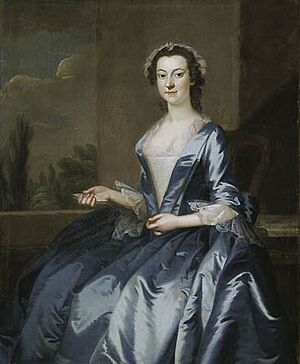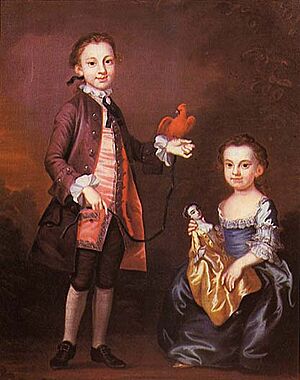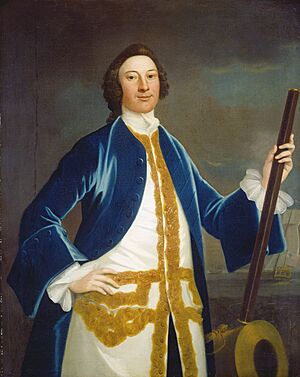John Wollaston (painter) facts for kids

John Wollaston was an English artist who painted portraits. He lived and worked a lot in the British colonies in North America. He was one of the first painters to bring the fancy English Rococo art style to America. He painted from about 1742 to 1775.
Contents
About John Wollaston
Not much is known about John Wollaston's early life. People think he was born in London and that his father was also a painter. Some say his father's name was John Wollaston, while others believe it was John Woolston, who later changed his name.
We also don't know much about how he learned to paint. An artist named Charles Willson Peale once wrote that Wollaston trained in London with a "drapery painter." This means someone who specialized in painting clothes and fabrics in portraits. Wollaston's painting style looks a bit like the work of other artists like Thomas Hudson and Allan Ramsey. It's thought that his teacher might have been Joseph van Aken, who often painted the clothes for these artists.
Wollaston saw himself as English, not American. We know this because a portrait he painted in 1751 had a label on the back. It said "Johnannes Wollaston Londoniensis," which means "John Wollaston of London."
His first known painting, from 1742, is a portrait of a religious leader named George Whitefield. This painting is still in the National Portrait Gallery in London. Other early paintings exist too, like a portrait of an unknown British Navy officer.
Wollaston's Travels in America
Wollaston traveled across the Atlantic Ocean in 1749. He first settled in New York City. There, he showed American customers the newest and most stylish ways of painting portraits from London.
In 1752, he traveled south. He spent a short time in Philadelphia before arriving in Annapolis, Maryland, by the spring of 1753. Over the next year, he painted about 60 portraits of people from Maryland.
Next, he moved to Virginia. Between 1755 and 1757, he painted many portraits of people living there. He kept using the same painting styles and poses he learned in London. Even though these styles were a bit old-fashioned by then, people still found them impressive.
By the fall of 1758, Wollaston was back in Philadelphia. The last time he was recorded there was in May 1759. It seems he might have visited the West Indies (islands in the Caribbean) before arriving in Charleston, South Carolina, in September 1765. Charleston was his last stop in America. He painted at least 17 portraits there before going back to London in May 1767.
After returning to London, he mostly disappears from history. The only other mention of him is in 1775. An old friend from the Leeward Islands happened to meet him in England.
Wollaston's Painting Style
John Wollaston's artistic style didn't change much during the 18 years he spent in the American colonies. His portraits often show rich, detailed fabrics and elegant poses. His subjects usually have a slight smile and distinctive oval-shaped eyes. Many of his poses seem to be copied from printed pictures called engravings.
Some of his later New York portraits include a landscape in the background. But most of his paintings focus on carefully showing the clothes of the people he painted. These clothes were an important sign of their social class. The way he painted eyes is quite unique and helps identify his paintings, even if they aren't signed.
His later works, especially those painted in Charleston, show people on a smaller scale. This was different from the larger size preferred by his customers in Maryland and Virginia.
Wollaston's Impact on Art
John Wollaston traveled more widely in the American colonies than any other painter of his time. He helped meet the growing demand for formal portraits from wealthy merchants and landowners. People respected his work a lot during his time. Poems praising him were even published in newspapers like the Maryland Gazette in 1753.

Wollaston had a big influence on younger artists, especially in Philadelphia. Painters like Robert Feke, John Hesselius, and Benjamin West copied his painting techniques and compositions in their own art. It's also likely that Jeremiah Theus learned from Wollaston's work when Wollaston was in Charleston. Theus then used some of Wollaston's techniques in his later paintings.
Today, you can find Wollaston's portraits in many museums. Some of these include the National Gallery of Art, the Detroit Institute of Arts, the Museum of Fine Arts, Boston, and the Brooklyn Museum of Art.
Gallery
-
Warner Lewis II and Rebecca Lewis, on loan to Virginia Historical Society
-
John Tayloe II, who built Mount Airy, Richmond County, Virginia
-
William Randolph III of Wilton House from around 1755. This painting is in the collection of the Virginia Historical Society.
-
Elizabeth Calvert, painted by John Wollaston. This painting is in the collection of the Baltimore Museum of Art.
-
Captain Charles Calvert, Governor of Maryland. This painting is in the collection of the Baltimore Museum of Art.










